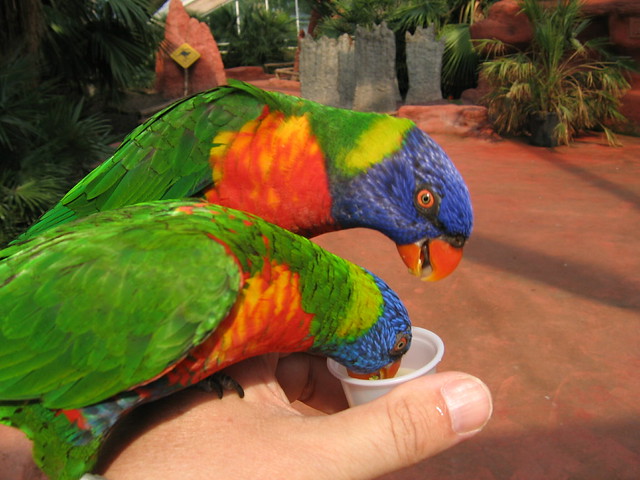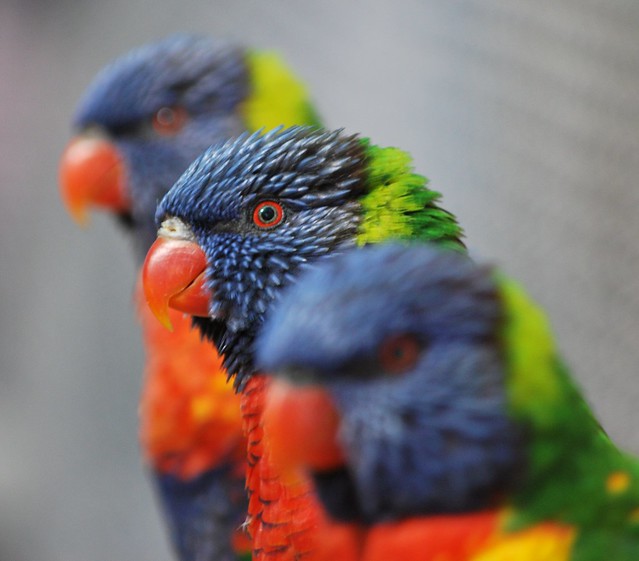 |
Rainbow Lories - Photo by hans s  |
They are approximately 30cm (11.8in) in length. The body, including the back and outside of wings, is green with a lighter green nape. The head is violet-blue with shaft streaking. The abdomen is also violet-blue. The chest is mostly red with yellow markings. The wings are orange-red underneath with a broad yellow band.
They have a specially adapted 'bristle-tongue' for eating pollen and nectar.
As Companion Pets
When it comes to Rainbows, every object and noise will be investigated with great delight and often turned into a game. They are born clowns as they like to be silly and exaggerate their movements. Lorikeets love to play and will often roll onto their backs to wrestle with your hands or play with a foot toy. A lorikeet may decide to hop instead of walk to get from A to B.
As they are so active, Rainbows need to be provided with plenty of toys. They are particularly fond of things they can swing on, make noise with and foot toys. While they like to shred things and occasionally chew, they aren't huge on chewing compared to many other parrot species.
Rainbow Lorikeets need a large-sized cage as they are quite energetic and tend to use every corner of it. They also love water and enjoy a bath or shower nearly every day.
They go to the toilet frequently and tend to 'squirt' their liquidy droppings rather than simply 'squat'. This increases the risk of faeces landing on the walls and outside the cage. Many lorikeet owners prevent this by putting plastic barriers on the wall behind the cage or clipping a sheet to the back of the cage. However, being liquid droppings does make them easy to wipe and clean up.
Diet and Health
Lories and lorikeets are specialised in eating nectar as their main food source. They also require more fruit compared to other parrots.
In captivity, a lorikeet's base diet should be either wet or dry nectar mix (or both). Wet is often preferred over dry, however, a high-quality dry version can be provided and the lorikeet will mix it with water itself (therefore, the water should be placed close to the dry lorikeet food).
Lorikeet food can either be bought commercially or there are a number of recipes for making it yourself, usually composed of baby cereal, rice flour, breadcrumbs, glucose powder, skim milk powder, semolina (wheat hearts), pollen mixture, etc. Lorikeets pellets are also available but are generally not recommended or accepted by the birds.
As well as the base diet, Rainbow Lorikeets should also be feed fruit and vegetables. Native Australian chemical-free flowers such as bottlebrushes are also appreciated. Be aware of foods high in iron as lorikeets are prone to health problems due to high levels of iron.
should also be feed fruit and vegetables. Native Australian chemical-free flowers such as bottlebrushes are also appreciated. Be aware of foods high in iron as lorikeets are prone to health problems due to high levels of iron.
A Rainbow Lorikeet's lifespan is around 20-30 years.
Mutations
There are now a number of established mutations (colours) of the Rainbow Lorikeet.
Rainbow Lorikeet mutations include:
- Greygreen (Olive)
- Dilute (Pastel)(often incorrectly referred to as cinnamon)
- Cinnamon
- Blue-fronted (Melanistic)
- Lutino (sex-linked)
- Fallow
- Recessive Pied
- "Olive"
- "Aqua"
- Black-eyed Yellow (Clear)("Acquired Yellow")(not yet established)
- Khaki (not yet established)
- "Mustard"
- "Jade"
There are also numerous different combinations of these mutations, creating even more variety.
A blue mutation was also found in a young wild lorikeet. Unfortunately, the individual died from injuries due to a bird of prey attack.
|

